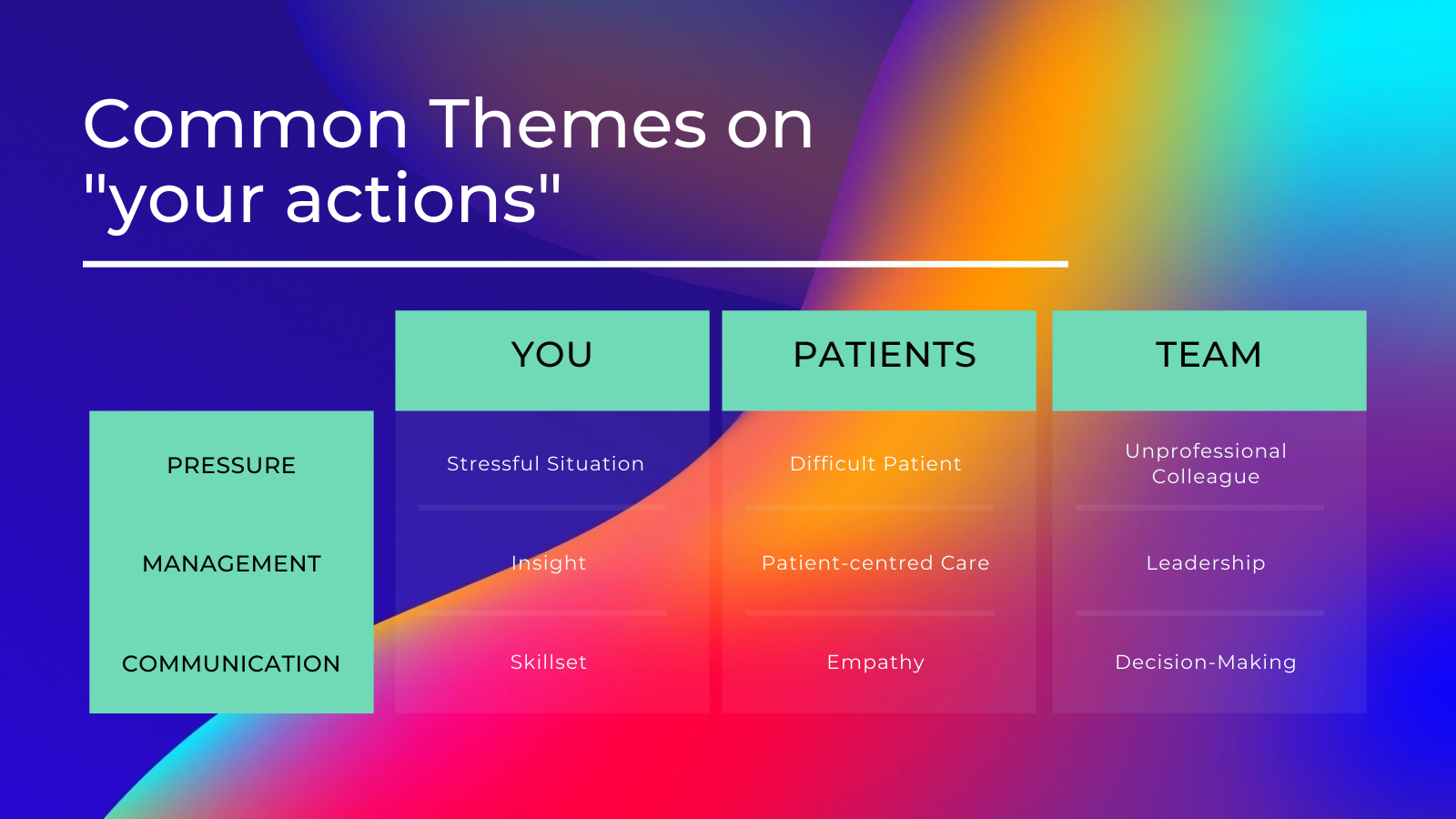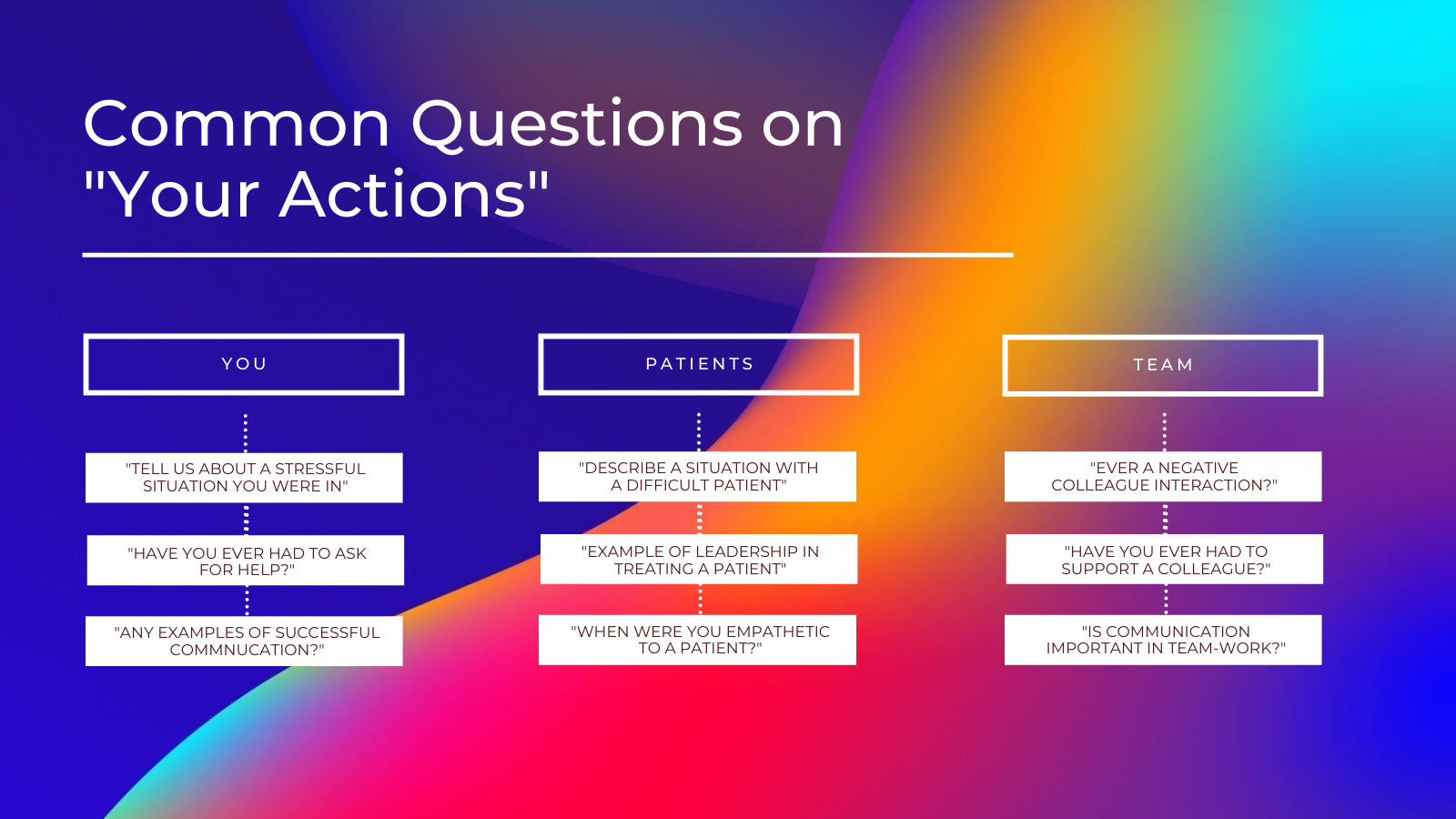Plastic surgery interview panels typically utilize a universal approach to gauge candidates' actions and decisions. They focus on themes central to the profession — how you handle pressure, manage clinical situations, and communicate with patients and colleagues. The SCARRED template is specifically designed to align with these themes, ensuring your answers resonate with the critical competencies sought in the field.
This is the perfect answer template when asked about any example, situation, or behavioral-based scenario in the Plastic Surgery Interview. This can be visualized in the infographic below.

There are specific themes to the "action" questions. But it's important for your brain to be able to recognise them quickly. After all, you really only have a few seconds in the interview to think. Below is the commonest questions asked, and when you hear them, you should flick on the "SCARRED answer structure template"

Situation
Key Point
Precisely outline the specific scenario, focusing on its relevance and complexity.
When asked a behavioural-based question, begin by concisely setting the stage for the scenario. This involves outlining the specific situation you were in, ensuring clarity and relevance to the question asked.
- Good Example: "During my rotation in pediatric surgery, I was faced with an emergency where quick decision-making was crucial."
- Bad Example: "I have faced many difficult situations in my career."
This response is too broad and non-specific. It fails to provide a concrete scenario, making it difficult for the interview panel to assess your problem-solving abilities or understand the context of your actions.
Context
Key Point
Elaborate on the setting and delineate your role, emphasizing the significance of your position in the scenario.
Provide details about the environment and your specific role or responsibilities in that context.
- Good Example: "As the lead surgeon, I was responsible for assessing the patient's condition and coordinating the team's response."
- Bad Example: "I was working at the hospital at that time."
This statement is vague and does not establish the relevant background or your specific role in the situation. It lacks detail on the setting or the challenges inherent to that particular context, which are crucial for understanding your response to the situation..
Action
Key Point
Clearly detail your actions, highlighting the decision-making process and the rationale behind your choices.
Detail the specific actions you undertook in response to the situation, showcasing your skills and decision-making.
- Good Example: "I quickly evaluated the patient and directed the team to prepare for immediate surgery, prioritizing tasks efficiently."
- Bad Example: " "I did what was necessary at the moment."
This answer is overly general and doesn't describe the specific actions taken. It fails to demonstrate your decision-making process, critical thinking, or specific skills applied in the situation, which are key elements the interview panel is looking to evaluate.
Result
Key Point
Describe the direct outcomes of your actions, focusing on both patient and team impacts.
Describe the results of your actions, focusing on both the immediate and any long-term outcomes.
- Good Example: "The surgery was successful, and the patient recovered quickly, demonstrating the effectiveness of our team's rapid response."
- Bad Example: "Everything turned out fine in the end."
This reply is unsatisfactory as it doesn't quantify the results or outcomes of your actions. It misses the opportunity to showcase the effectiveness of your decision-making and the positive impact of your actions.
Reflection
Key Point
Provide deep insights into what you learned and how the experience influenced your approach to plastic surgery.
Offer insights into what you learned from the situation and how it impacted your professional growth.
- Good Example: "This experience taught me the value of quick decision-making under pressure and reinforced the importance of teamwork in crisis situations."
- Bad Example: "It was a learning experience for me."
This response is cliché and lacks depth. It doesn't articulate what was learned or how the experience contributed to your professional growth. Reflective answers should provide insight into your thought process and how such experiences have refined your approach or philosophy in plastic surgery.
EDucation
Key Point
Connect the experience to your educational growth and professional development in a tangible and specific manner.
In the EDucation component, focus on how the particular situation has influenced your educational journey and professional growth in plastic surgery. This is about connecting real-life experiences to your continuous development as a medical professional, highlighting any new skills, knowledge, or perspectives gained.
- Good Example: "Following the complex case I managed during my residency, I identified a gap in my knowledge regarding advanced reconstructive techniques. This led me to enroll in a specialized course on microvascular reconstruction, significantly enhancing my surgical skills and understanding of patient-specific approaches."
- Bad Example: "I always try to learn from my experiences."
The good example effectively shows how a specific experience directly influenced a decision to pursue further education, leading to tangible professional growth. The bad example is too general and fails to demonstrate a direct link between experience and educational development. The bad example is too generic and doesn't tie the learning back to the specific situation or how it influenced your educational path or professional development. Effective answers should connect the experience to specific learning outcomes or future goals.
Clearly articulate how the situation prompted a specific educational pursuit or professional advancement. This could include additional training, certifications, research, or any form of formal or informal education that contributed to your growth as a plastic surgeon.


